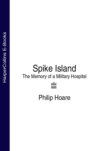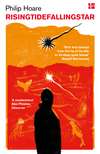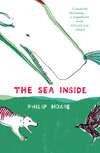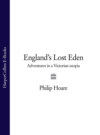Kitabı oxu: «Spike Island: The Memory of a Military Hospital»

Copyright
William Collins
An imprint of HarperCollinsPublishers
77–85 Fulham Palace Road
London W6 8JB
First published in Great Britain by Fourth Estate in 2001
Copyright © Philip Hoare 2001 and 2002
The right of Philip Hoare to be identified as the author of this work has been asserted by him in accordance with the Copyright, Designs and Patents Act 1988
A catalogue record for this book is available from the British Library
All rights reserved under International and Pan-American Copyright Conventions. By payment of the required fees, you have been granted the nonexclusive, nontransferable right to access and read the text of this e-book on-screen. No part of this text may be reproduced, transmitted, downloaded, decompiled, reverse-engineered, or stored in or introduced into any information storage and retrieval system, in any form or by any means, whether electronic or mechanical, now known or hereinafter invented, without the express written permission of HarperCollins e-books.
HarperCollinsPublishers has made every reasonable effort to ensure that any picture content and written content in this ebook has been included or removed in accordance with the contractual and technological constraints in operation at the time of publication.
Source ISBN: 9781841152943
Ebook Edition © AUGUST 2014 ISBN: 9780007394586
Version: 2014-08-26
Map

Philip Hoare was born in Southampton and brought up next to Netley’s military hospital. He is the author of Serious Pleasures: The Life of Stephen Tennant (1990); Noel Coward: A Biography (1995); and Wilde’s Last Stand: Decadence, Conspiracy & the First World War (1997). His film on Hampshire for BBC2’s Travels with Pevsner was broadcast in 1998, and in 1999 he co-curated the Icons of Pop exhibition at the National Portrait Gallery. He lives in London.
‘A book that has everything a passionate reader could want – a subject that far transcends the trivial pursuits of contemporary writing, concerns both public and private, astonishing details, stylistic precision, a unique sense of time and place, and a great depth of vision.’
W. G. Sebald, Sunday Telegraph Books of the Year
‘A brilliantly evocative memoir of childhood in a landscape, and a sensitive, absorbing account of the Royal Victoria Hospital as a locus of the grandeur and misery of Britain’s apogee as an imperial and global power … Spike Island is [an] intensely personal, compelling work.’
Paul Smith, Times Literary Supplement
‘Punctuated with grief and loss, cross-cut with flashbacks to the author’s suburban boyhood, this biography of a hospital is gruesome, startling, grainily authentic, as if Hoare were inching his way through history’s dark wood with a hand-held camera, reporting what he sees in close-miked voiceover. Spike Island comes as near as it is possible to get to a scholarly equivalent of The Blair Witch Project.’
Hilary Spurling, Daily Telegraph
‘No one could describe the scenes of this hospital in a more evocative fashion than Philip Hoare. His history of Netley is alternately poignant and brutal.’
Joanna Bourke, Independent
‘A heterogeneous mix of familial reminiscence and conjecture, aesthete’s Bildungsroman, countless fragments of lives, countless fragments of anecdote, meditations on the nature of romanticism and of the Gothic.’
Jonathan Meades, Evening Standard
‘Hoare’s … insights … achieve a similar suggestiveness – a sense of lost worlds dragged back into view – to that of W. G. Sebald’s spooky crisscrossing of Suffolk in The Rings of Saturn … [He makes] you want to go straight down to Southampton.’
Andy Beckett, Guardian
Dedication
For Leonard, Andrew and Peter
Contents
Cover
Title Page
Copyright
Map
Dedication
PROLOGUE
PART I
Spike Island
In a Lonely Place
Southern Gothick
PART II
Pray Stop All Work
In the Very Best Style
A Remarkable Improvement
Enter His Gates with Thanksgiving
Remembrance Day
D Block
Towards a Better Britain
PART III
His Dark Estate
The World is Infinitely Forgiving
EPILOGUE
AFTERWORD
Keep Reading
Source Notes
Index
Footnotes
Acknowledgements
About the Publisher
Prologue
To the unsuspecting visitor approaching from the seaward side, it looked like any other large country estate. Next to the great iron gate topped with glass lanterns was a low porter’s lodge, but on the other side of the drive stood a sentry box, occupied by a uniformed soldier.
To that newcomer, the first intimation of the extraordinary building that lay ahead was the glimpse of Italianate towers over the parkland’s newly-planted firs. As he walked up the lane, the vastness of Netley’s Royal Victoria Military Hospital would suddenly be revealed. Rising over Southampton Water was a classical skyline, dominated by a central dome. From this sublime eye-catcher the visitor’s gaze ranged in disbelief, scanning an edifice so wide that he had to move his head to see it – no one glance could take it all in.
Flanking the grandiose verdigris dome in either direction were great arms of Welsh granite, Portland stone and Hampshire brick – indeed, the clay to make the bricks had been excavated from the site itself – each crowned with their own spires and turrets. At their ends, these elongated wings bent back on themselves – as if too long for their own site – to form galleried barracks at the rear; as one architectural historian was to note, ‘each would make reasonable major buildings in themselves’. In their deceptive embrace, the hospital was actually twice as big as it first appeared: it was as if it stretched into infinity.
Everything about the place was monumental. Its architecture aspired to eighteenth-century rationality, yet it spoke of nineteenth-century imperialism. Somehow the sense of proportion had been subtly overbalanced, as though designed by a team of architects whom no one had told when to stop, its creators having suffered a fit of megalomania. If there had been a soundtrack to that revealing first sight of the hospital, it might have been provided by Richard Wagner, then composing his equally grandiose Ring Cycle.
But the building was also the product of bureaucracy, dwarfing the mere human like some enormous town hall conceived by committee. From a dark interior of the War Office, orders had been issued to E. O. Mennie, Surveyor of the Royal Engineer Department, and his army of assistants in Pall Mall, an architectural sweatshop producing sheet after sheet of plans, measurements and specifications. This was a building under royal patronage, created by the richest and most powerful nation on earth, and nothing was to be spared in realising its imperial vision.
The exhaustive plans demanded ‘the best hard, sound, well-burnt and square stock bricks’, ‘the piers and arches to be of the best Portland stone’, ‘the whole of the ornaments, carvings and enrichments to be done in the very best style, with spirit, boldness and without blemish’. Nor was the interior neglected. In true Victorian tradition, every item was specified in a manifesto published for the contractors, E. Smith of Woolwich. Each fixture and fitting was defined: from ‘blue pointing mortar’ to ‘fresh air tubes’, from ‘Rufford and Finch’s baths’ to ‘Anglo-American stoves’, from ‘wine bins’ to early washing machines; every article of equipment, ironmongery and furnishing was listed ad infinitum. In an age of mass production, this was architecture by multiplication, as though the hospital had been built by a great Victorian machine. Its façade reached one quarter of a mile in length, pierced by row upon row of arched windows, more than two hundred of them, regimented along three cliff-like storeys. The detail was overwhelming, almost hypnotic in its rhythm.
The new hospital was a statement of imperial intent, an advertisement in brick and stone of the country’s international standing; it would make Netley a household name. A later report would note that ‘Passengers by Cape and American line steamers, and those who journey up and down Southampton Water, are familiar with the immense façade of the hospital, built in red brick and Portland stone, with pillared porticoes of granite, and towers and windows which in some way suggest stately Venetian palaces.’ Half-imaginary engravings of the building created before its completion depicted it as a kind of waterside Versailles, complete with parterres and decorative sheep cropping its neat turf, and gravel drives along which carriages could take the air, as if on some elegant gentleman’s estate.
Framed by its greensward and, set back from the sea, looking out magisterially over the empire it was built to serve, the hospital straddled its 200 acres with immutable solidity. A remarkable aerial photograph taken soon after its completion reveals the scale of a building that had to be measured in yards and furlongs rather than feet. The balloon-borne camera rose smoothly into space above Southampton Water, the only way to capture the extent of the hospital as it stretched along the shore, set on some vast pedestal for display to the passing yachts and oyster boats, troopships and liners. Like the Great Eastern, which moored alongside it in 1861, reflecting the new building in Brunel’s enormous million-pound creation – five times bigger than any other ship afloat, part-yacht, part-factory, part-hotel, with its stovepipe chimneys like his stovepipe hat – Netley’s hospital was a grand, if not arrogant display of technological progress.
For the Great Eastern’s passengers, as for the soldiers on troopships en route for foreign postings, Netley was a reminder of Britain’s greatness, a symbol of power and potential succour as they sailed down the water to extend or defend the Empire. But for those inside the building, the hospital held different prospects. For all its glittering window eyes, it remained faceless, impenetrable, keeping its own secrets. Yet viewed in perspective from the literal height of nineteenth-century technology, the entire undertaking appeared almost shimmering in its new brick and stone; a magnificent delusion, a Victorian vision for a miraculous age.
Having paused to take in the enormity of the view that confronted him, the awed visitor would walk along the hospital’s façade, counting the rows of arched windows as he went. Reaching the central portico, he would pass through the great double doors and into the building itself. Here, in a high-ceilinged and panelled hallway reminiscent of a railway hotel, he would be greeted, not by scurrying nurses and doctors in white coats, but by the bleached white bones of a full-size elephant.
This was the hospital’s Museum of Natural History, a room-sized cabinet of curiosities guarded by its ghostly and eyeless pachydermic porter. Ranged above the stone staircase was a cluster of spiky antelope horns and deer antlers – the kind of display you’d find gathering dust in any country house of the time, trophies of exotic shooting parties in the bush or the veldt. But crocodiles also crawled the walls, and a school of stuffed fish swam under the stairs, frozen mid-stream in the plaster. Other animal remains had been cemented in their death rictus, and on the shelves of one long vitrine, the length of a wall, stood tens of glass specimen jars, each containing the spiralled pickled corpse of a snake. It was hardly the kind of exhibition to calm the fears of a nervous hospital patient.
Yet this gloomy dissection of the natural world had an even more gothic counterpart in the hospital’s other collections. One was devoted to military surgery, and had been started in Dublin in 1846 by a retired army surgeon, Professor Tufnell, as ‘a museum of appliances for the transport and treatment of the wounded’. Brought to Netley to grace the new hospital, it displayed ‘native’ weapons next to surgical instruments, described in lugubrious nineteenth-century tones as ‘the implements by which man ingeniously shortens his neighbour’s life and the appliances by which he seeks to preserve his own’ – in other words, a visual lesson in the survival of the fittest. One item on show was a broken lance which had passed through the body of a lancer after his horse threw him. ‘The lance had to be sawn in two before it could be withdrawn’, it was noted, ‘but marvellous to relate, the man survived and was perfectly cured.’
In one corner stood an antler-like hatstand festooned with headgear from the battlefields of the Crimea, resplendent with red plumes and glossy cockades like stuffed birds of paradise. Meanwhile in another nearby case, neatly stacked on shelves like bowling balls waiting for a game, was a collection of decapitated and mummified heads. These represented indigenous peoples from around the imperial world: the inhabitants of Java, New Zealand, Malay and Africa, arranged for anthropological identification and scientifically labelled – ‘Kaffir: Tambuki tribe’; ‘Kaffir: Amulosali tribe’; Hottentot and Maori. Like the animals in the entrance hall, they too were endangered species: Tasmanians killed off by the colonial process or the South Africa San ‘bushmen’ who would even a hundred years later still be regarded as suitable subjects to be hunted.
This index of Victorian anthropology had come from the catacombs of Fort Pitt, Kent, where the director, Sir James McGrigor, had assembled no less than 458 skulls, 29 casts, 7 dried heads and 2 mummies. Expanded by an appeal, made in 1833, for new specimens of ‘Monstrosities’, ‘the bodies of foetuses at different ages’, ‘crania of various races of mankind’, and ‘snakes and lizards from the Colonies, preserved in spirits’, the collection had acquired a national reputation, visited by ‘distinguished surgeons and naturalists’. It had been transferred to Netley when the hospital opened, ‘rather a gruesome sight’, admitted a contemporary account, ‘but to the student of anthropology the facial characteristics of the different peoples are full of interest’. The ‘ghastly array’ was, ‘for those not accustomed to such display … not very agreeable’, agreed another Victorian guide, ‘but people come from far and wide to see it; from Germany, France, America, for it is one of the best collections of Asiatic and African skulls in the world’. Whatever its scientific merits, the ironies of this gothic ossuary in the entrance hall of their hospital were not lost on the inmates. They nicknamed it ‘Skull Alley’.
In a burgeoning scientific age, the new theories of evolution and natural history had spread even to the officers’ quarters at Netley. A gracious villa-like building with twin Italianate towers (a deliberate echo of Queen Victoria’s holiday home, Osborne, just across the Solent on the Isle of Wight), its well-appointed rooms fit for gentlemen were separated from the hospital by fir trees.
These had been planted not only for decoration, but for their medicinal qualities: the healthy scent of pine oil provided a barrier between their quarters and the miasma of the great building across the lawn.
In this refined white contrast to the hospital’s red-brick rigours, surgeons and doctors dined to a theatrical backdrop of aspidistras, palms and a huge decorative screen embellished, not with nineteenth-century ‘scraps’ of ladies in décolletage and blowsy roses, but with florid recreations of Victorian dinosaurs. Besporting themselves in an antediluvian jungle, these monsters were the cousins of those at Crystal Palace, where Benjamin Waterhouse Hawkins’s saucer-eyed ichthyosaurs and arched-neck plesiosaurs reared out of the primordial swamp in a London park. Hawkins had begun his dinosaur theme park in 1853, shortly before work started at Netley, and had invited Richard Owen – the inventor of the name and concept of the dinosaur – to dine with him in the cement carcass of an iguanadon under construction; Netley’s officer doctors would have to make do with eating in the shadow of prehistoric monsters.
As they sat at their mahogany dining table, these men of science doubtless discussed Mr Darwin’s theories, published in 1859 and exemplified by the living dinosaurs of the Galapagos, the lumbering swimming lizards which he called ‘imps of darkness’, just as he called himself the ‘Devil’s chaplain’. Only later would Netley bear witness to the more problematic offspring of evolutionary science: social Darwinism.
Victorian man was busy digging into his past to explain his present, the reason for his supremacy. If ‘Skull Alley’ and the expanding Empire provided living proof of one aspect of the theory, then dinosaurs were the prehistoric exemplars of another. Indeed, the two sensibilities combined in Alfred Waterhouse’s secular gothic cathedral of the Natural History Museum, built ten years after the hospital in 1873, complete with demonic terracotta pterodactyl gargoyles hanging by their leathery wings from a façade which, like Netley’s, appeared to emulate geological strata in its layers of brick and stone, yet which, like the Gothic Revival, also referred back to a medieval past.
That had been an age of unwavering faith. Now the search for an explanation of Man’s origins became a metaphor for the loss of faith, in an age in which science and religion battled for the hearts and souls of Victorian man. In that battle the hospital would become a resonant symbol. For a hundred years it would bear testimony to the rise and fall of the Empire; to reason and rationality subjected to forces of superstition and fear; to issues of class and sex; to experimentation and scientific advance – sometimes at the expense of human beings. This vast building would stand for a century of British history, but it too was a dinosaur, excavated from Hampshire clay; the monster on Netley’s shore.
When I was twelve years old, my family went on holiday to Scotland. It rained most of the time, and we took shelter in a series of guest houses and caravans. At Inverness we spent the night in a bed and breakfast seemingly constructed from a series of extensions joined together by skewed corridors and acrylic carpet. We younger children – myself and my two younger sisters, my brothers now too old for family holidays – were bedded down in a creaky room covered in white-painted woodchip wallpaper. I was excited: the next day we would be arriving at Loch Ness. We were already at the head of the huge body of water which, as I was at pains to tell my parents, was twice as deep as any of the water around Britain. I seemed to feel its nearness and its depth; and in that depth, the presence of its alien denizen, the reason for my excitement.
Ever since I could remember seeing pictures in the newspapers or hearing jokey items at the end of the news, I’d felt affronted by the cynics who rejected its existence, the so-called experts from the Natural History Museum who were trundled out every time there was a new sighting. Implacable in my belief, I knew what it was; a childhood spent with my head in dinosaur books told me as much. Their vivid reconstructions of prehistory were photographically real to me, and as scary as the pictures of deep-sea fish in my encyclopaedias which I could not touch – I had to turn the page with my fingertips, as if the lithographic image could, by a process of osmosis, drag me to unfathomable depths and into the nightmare jaws of the angler fish. My faith in the loch’s monster was a gesture of defiance against the sceptical adult world. At home in Southampton, living within the sound of the sea yet encircled by suburbia, I was always fascinated by monsters and ghosts; by the bottomless ocean and the endless forest; by derelict buildings and damaged beauty; by loss and memory – by the memory of things and places I’d never seen. Myths and legends seemed more real to me than the reality around me. I sought to glamorise my everyday life; to find something strange and perhaps even mystical beyond it – to populate those ruinous buildings with ghosts, and to fill the sea with monsters.
That night, as I slept in my Inverness bunk, I looked down, not into unknown depths, but on the shallow end of the loch, where the waters petered out into reedy marsh. The scene was sunlit, the reeds yellow-russet, the sky blue, the water clear and still. It was picture-postcard bright, not gloomy and grey like other images I’d seen of the place. And as I watched from my elevated position, looking down, as it were, as though filming the scene from a camera on a crane, a slow-moving greenish-brown form slipped up and out of the water beneath me; obscenely snakelike and sinewy, its massive, muscular bulk was not out of place in the natural landscape, but somehow part of it, or lord of it. It undulated through the shallows, its full serpentine length visible through the clear water, its indiscernible lower reaches stirring the silt below. It moved powerfully and swiftly on, its broad slow-worm head held high as it swam towards the open loch.
Then it was gone, and I woke up.














